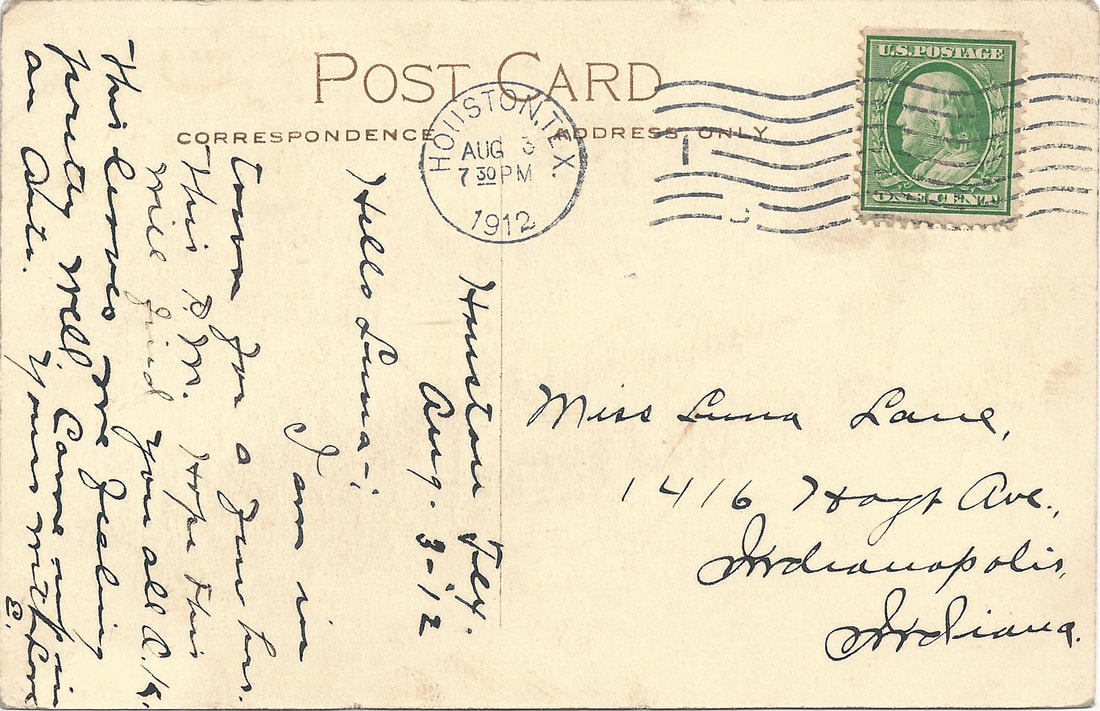Sam Houston Park Gate
|
3 August 1912: Established in 1899, Houston’s first park was City Park, soon renamed Sam Houston Park. The formidable gate, which would presumably locked at night, bears three signs: 1) “Warning $5.00 to $500.00 Fine for Defacing City Property;” 2) “For Whites Only;” 3) “Dogs Positively Prohibited.” A number of civic artifacts are visible behind the gate. On the left a plinth honoring Terry’s Texas Rangers, further back a gazebo, and a ship’s bell from the Harriet Lane, a Federal Ship captured in the Civil War. Benjamin Franklin Terry (1821-1861) was a cotton and sugar cane planter owning 13 slaves in 1860 in Fort Bend County southwest of Houston, who organized the 8th Texas Cavalry Regiment, “Terry’s Texas Rangers” for service to the Confederacy. Co-founding Terry’s Texas Rangers was Thomas Saltus Lubbock (1817-1862), namesake for Lubbock, TX and brother of the governor of Texas during the Civil War, Francis Richard Lubbock (1815-1905). The Harriet Lane monument was erected in 1903 to honor the revenue cutter named for the niece of President James Buchanan, captured by Confederate forces on January 1, 1863 and held as a war trophy (for further details on this monument see Harriet Bell).
|
26 December 2016: The position of the re-photograph depends on the assumption that the Gazebo has remained in the same location since 1912, which could not be verified. The Harriett Lane bell has been relocated several times since 1912, and now rests in a narrow lot between incoming Dallas and outgoing Lamar within the park, rechristened incoming and outgoing Allen Parkway lanes. The current location of the monument to Terry’s Texas Rangers could not be determined. The park gates still close tightly at night, assuring that the considerable homeless population of Houston does not try to shelter there.
|
|
Postmarked: 3 August 1912; Houston, Tex.
Stamp: 1c Green Ben Franklin #374 To: Miss Luna Lane 1416 Hoyt Ave. Indianapolis, Indiana. Message: Houston, Tex. Aug. 3- ‘12 Hello Luna-: I am in town for a few hours this P.M. Hope this will find you all O.K. This leaves me feeling pretty well. Came up in an auto. Yours with Love E. |
Luna Lane was 21 when she received this postcard in Indianapolis. She was from Decatur County about halfway from Indianapolis and Cincinnati, OH, a 50 mile trip to the city. Her parents, Elihu Preston Lane and Lorena Bell Brown, had married in 1889 in Decatur County and raised a family of four children: Della Mary (1889), Luna Leta (1891), Marie Gaynelle (1894), and John W. McKinley Lane (1896). Her mother was widowed by the time Luna moved to the city, working as a housekeeper in a private home with the assistance of her daughters. When Luna moved to Indianapolis, she apparently stayed in a boarding house while looking for work. By this time her sister Della had married in 1905 to Frank Grover Creach, and was mother to two children. Her other sister Marie Gaynelle was about to marry Chriss Reiger in a month, leaving her mother with the care of just her brother McKinley, a 16 year old teenager, so it was a good time for Luna to be out and on her own.
She met married a young man from Knoxville, TN, Arthur T. Henry, who was living in Indianapolis while working as a machinist. She moved with him to Atlanta and married him there on 8 October 1917. Arthur came from a large family of seven children: Minnie (1883), Arthur himself (1888), Willie J. (1890), Rosa Mabel (1893), Robert W. (1896), Eugene (1899), and Willard L. (1903). His father William made a living as a farmer and carpenter, his mother was Julia Arrington. When Arthur came of age he worked as a traveling lumber grader, first in forests around Knoxville, then further afield in Hamilton County, OH before moving to Indianapolis and more industrial employment. Arthur and Luna made their lives in Atlanta, eventually managing a service station for their livelihood. They never had any children, and seem to have led rather quiet lives far from the relations on either side. When they died cannot be determined. Luna’s correspondent “E” left too few cues to be identified. |

